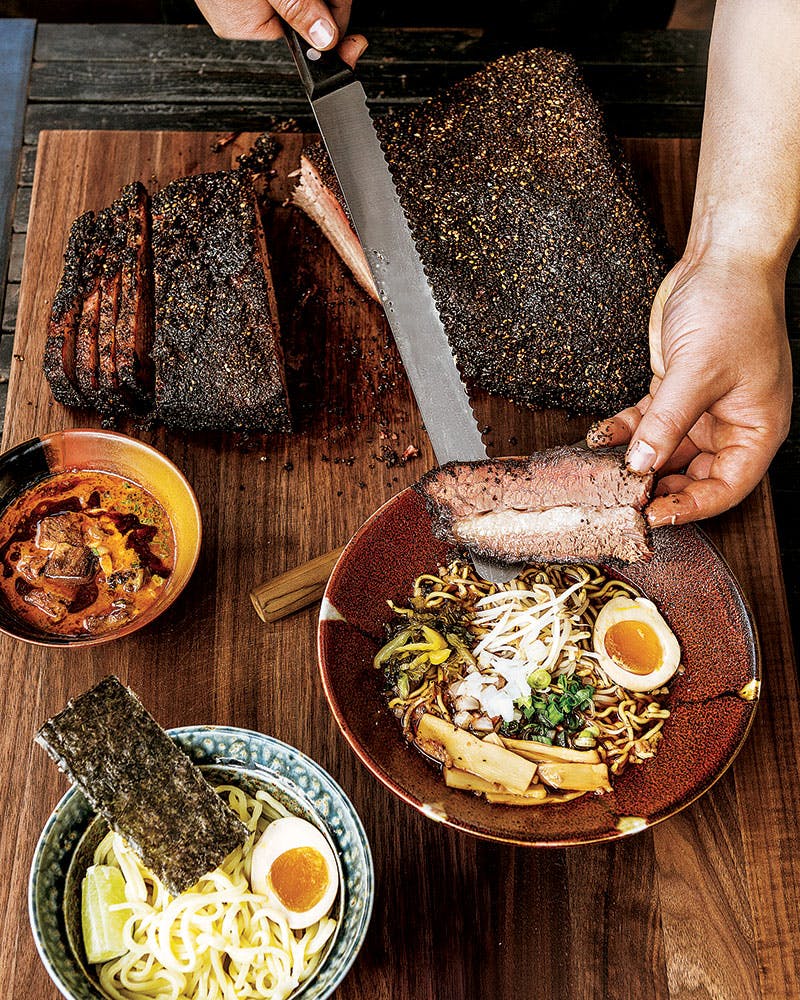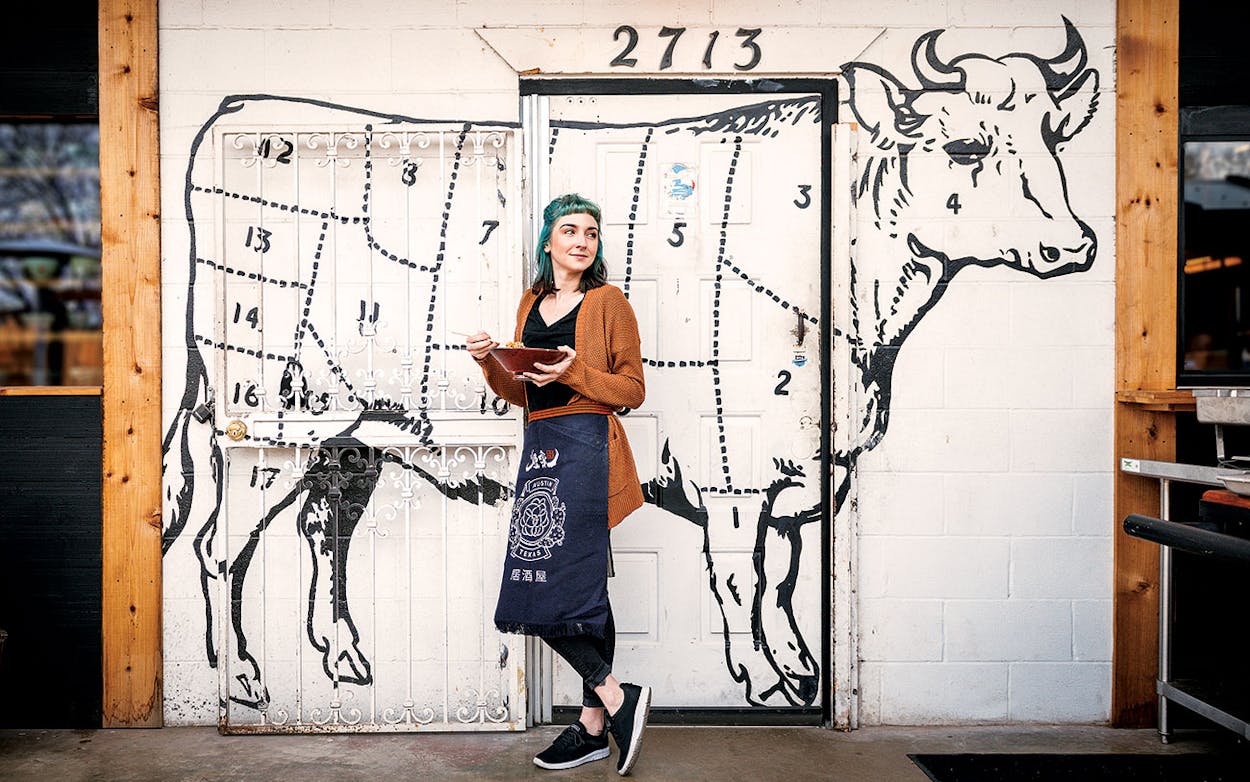Tatsu Aikawa was just ten years old when he left Tokyo for his new home in Elgin, the sausage capital of Texas. His mother and father had divorced, and she had taken him and his younger brother, Shion, to the U.S. It’s hard to imagine a more stark difference in landscape, or a greater cultural shift. The family would eventually relocate to Austin, but their time in Elgin would prove serendipitous: there was a smoker in the yard, and Tatsu’s mother put it to good use, giving him an early education in the art of smoking Texas style, albeit with different materials. “We cooked fish instead of brisket,” Tatsu told me.
As an adult, Tatsu traveled the familiar path from dishwasher to prep cook to sous chef to successful restaurateur, meeting along the way Takuya “Tako” Matsumoto, an Austin native and Le Cordon Bleu graduate, while they were both moonlighting as DJs in clubs around town. They bonded over their shared longing for authentic Japanese cuisine, especially ramen, so they decided to figure out how to make it themselves. After a brief stint in Los Angeles, where Tatsu worked for the Michelin-starred Urasawa, he came back to Austin with recipes and a plan for what would become Ramen Tatsu-Ya. Along with Tako and Shion, he opened the tiny noodle shop in 2012, and it immediately set the local dining scene on fire. There were lines out the door of the modest strip-center spot and, later, accolades from Bon Appétit, Food & Wine, and Time Out USA, which declared Tatsu-Ya’s ramen the best in the United States. Much of that success no doubt came from the authenticity of the cooking. “We didn’t want to Americanize it,” Tatsu stressed.

But he couldn’t resist the siren call of that Elgin smoker, and it wasn’t long before he was adding brisket from Smitty’s Market into his tonkotsu ramen. In 2015, Tatsu and Tako collaborated with Austin’s preeminent pitmaster, Aaron Franklin, featuring his brisket at their two Ramen Tatsu-Ya locations (the second had opened early that year) and also appearing on his PBS show, BBQ With Franklin. Tatsu was hooked on this Japanese-Texan mash-up, and he started to think about opening another ramen shop, one whose menu would incorporate even more barbecue. The three partners set off to find a spot to house the new restaurant and, as luck would have it, discovered that the former home of Live Oak Barbecue, in East Austin, was available, as was its smoker. They signed the lease and got busy experimenting with the pit. But Tatsu quickly realized that his ambitions were grander than ramen. “I had more of a story to tell,” he said. And so the ramen shop became an izakaya, Japan’s version of a gastropub, and the smoker they’d inherited became the workhorse for what Tatsu would describe as “a Japanese immigrant’s conversation with Texas barbecue.”
As I discovered when I sat down for a meal at Kemuri Tatsu-Ya (“kemuri” is Japanese for “smoke”), that conversation is one you’ll want to sit in on. With a chunk of luscious smoked meat between your fingers and a tangy vegetable within reach, it’s hard to ignore the parallels between Kemuri and any other Texas barbecue joint. Never mind that the meat is octopus, and the vegetable is sunomono, a vinegary cucumber salad. If you’re still not convinced, one bite of the hamachi kama, or yellowtail collar, should do the trick. The prized cut just below the gills is cold-smoked, then hot-smoked, then grilled over Japanese binchotan charcoal. Unimaginably rich, it’s the sea’s answer to fatty brisket. I asked Tatsu if the plan was to create a Texas barbecue joint all along. “Yes and no,” he said. “We’re just freestyling.” There is brisket on the menu (lean or “toro”), served on its own or as part of the popular BBQ Boat (also filled with items like smoked pork loin, duck breast, or eel, depending on the day). But honestly, in a place like Austin, where excellent brisket is easy to find, it’s the least compelling thing on the menu. Kemuri’s freestyling attitude is best exemplified by playful items like the Hot Pocketz—brisket and smoked Gouda inside a tofu skin scattered with melted cheddar cheese—and the Chili Cheese Takoyaki, an imaginative take on Frito pie that uses crispy octopus instead of chips. And, of course, the ramen guys would not leave you without ramen. But instead of creamy tonkotsu or chicken shoyu, it’s ramen made with smoked beef bones, with additions like brisket, lime, and jalapeño.
It is unmistakably barbecue, but is it Texas barbecue? Absolutely. In Kemuri, Austin is bearing witness to the start of a new chapter in the ever-expanding book of barbecue. Immigrants—Germans in Lockhart, African Americans in East Texas, Sicilians in Waco—are at the root of our traditions, so it should be no surprise that they would also be part of their evolution. With its refreshing fusion of flavors and techniques, Kemuri is an oasis for barbecue lovers who already had a three-meat plate for lunch. Whether or not it meets your definition of barbecue is something you can decide for yourself after you finish your meal—and don’t forget the roasted-banana pudding.









